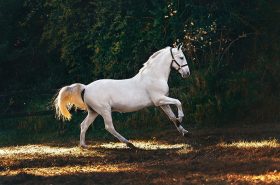From the first few rides to the ultimate level of collection, the training pyramid can help you reach your dressage goals.
The training pyramid in classical dressage can be seen as an outline for your horse’s training journey. It begins with their first few days under saddle and continues for several years later. This process doesn’t happen overnight. In fact, classical dressage maintains the philosophy slower is better than faster. The horse prospers on the ground, before they’re even started under saddle.
When working through the training pyramid, it’s essential to begin at the bottom and work your way upwards to achieve true collection. It will take time and dedication; however, nearly any horse can reach the top with proper instruction and practice. This system of training has been perfected over countless generations.
Rhythm
The foundation of any horse, rhythm holds strong at the bottom of the pyramid. It refers to the time between footfalls in your horse’s stride. It’s not about speed, rather good quality of movement. You want your horse traveling forward freely with energy. During this time, your horse should remain balanced and maintain the appropriate level of self-carriage for their training level.
Relaxation
The horse’s muscles should be loose and supple. Unfortunately, suppleness is often taken to an extreme level. The goal is to gradually increase the flexibility of your horse to include their bend through the ribcage, swinging in the back, flexion at the poll, and softness in the rider’s hands. The mental state of your horse is just as important. They should accept your aids without becoming tense.
Connection
This stage of the pyramid refers to having your horse on the bit. When your horse is connected through the bit, you should have contact with their mouth through the reins. The hindquarters generate driving energy that flows through the horse and is captured by the rider’s hands. In order for a horse to be connected, they must be willing to truly accept the rider’s aids. This third stage requires the ability to control each part of your horse’s body independently.
Impulsion
Your horse’s hindquarters create the energy looked for in this section. It’s about the “thrust” produced not so much the speed. Your horse’s hindquarters should be engaged and energetic. They will begin to lift through their back and a swinging motion in each gait is achieved. Each hind leg will step far underneath them.
Straightness
Every horse is naturally crooked and therefore stiff on one side. It’s the rider’s job to encourage the horse to be straight or properly aligned and balanced. Your horse is able to activate their greatest amount of power from their haunches when they are straight throughout their body. Each leg needs to evenly step underneath, in order to reach their ultimate pushing and carrying capabilities.
Collection
In simple terms, collection is achieved when the horse transfers more weight to their hindquarters, thus maintaining an uphill position, while on the bit. It requires self-carriage, lightness on the forehead, and engaged hindquarters. Every horse is capable of reaching some level of collection. It may be more challenging for some conformation types, but it can be achieved.
Your training sessions can have clear goals when you work through the levels of the training pyramid. Every horse can benefit from learning proper movement and how to carry a rider. With patience, instruction from a classical teacher, and practice, there is little stopping you from reaching the top!
**Emily Fought discovered her passion for horses early on in life. When she isn’t writing about them, you can find her in the barn riding. Although Emily’s background is in dressage, she enjoys cross-training and is an avid trail rider. She resides in Northwestern Pennsylvania with her husband and small dog. Together, they own and operate Humblewood Farm.




